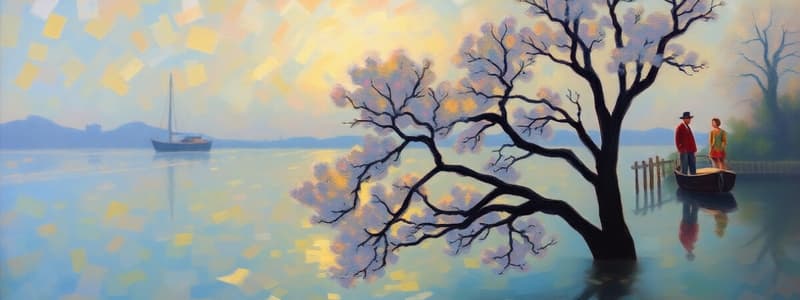Podcast
Questions and Answers
What does Aristotle define art as?
What does Aristotle define art as?
Art completes what nature cannot bring to finish.
What does Michael Angelo say about the work of art?
What does Michael Angelo say about the work of art?
Work of art is but a shadow of the divine perfection.
What is the role of line in art according to Johann Wolfgang Von Goethe?
What is the role of line in art according to Johann Wolfgang Von Goethe?
Mediator of the unspeakable; it can speak volume.
Which characteristic of art is described as unique?
Which characteristic of art is described as unique?
Art is an expression of man's ideas, imagination, and _____
Art is an expression of man's ideas, imagination, and _____
_____ is the oldest universal element in art.
_____ is the oldest universal element in art.
Which of the following is a type of traditional art?
Which of the following is a type of traditional art?
The ____ refers to enclosed space in art.
The ____ refers to enclosed space in art.
Which of these colors cannot be formed from mixtures?
Which of these colors cannot be formed from mixtures?
Filling in the blank: The relevance of value is to the lightness or _____
Filling in the blank: The relevance of value is to the lightness or _____
What is texture in visual art?
What is texture in visual art?
Flashcards
Definition of Art
Definition of Art
An expression of man's ideas, imagination, and emotions.
Space (in Art)
Space (in Art)
The distance or area around, between, and within components of a work of art
Line (in Art)
Line (in Art)
Indicates direction, orientation, movement, and energy in a composition; the oldest universal element and it starts with a dot.
Shape (in Art)
Shape (in Art)
Signup and view all the flashcards
Form (in Art)
Form (in Art)
Signup and view all the flashcards
Color (in Art)
Color (in Art)
Signup and view all the flashcards
Value (in Art)
Value (in Art)
Signup and view all the flashcards
Emphasis (Art Principle)
Emphasis (Art Principle)
Signup and view all the flashcards
Harmony (Art Principle)
Harmony (Art Principle)
Signup and view all the flashcards
Variety (Art Principle)
Variety (Art Principle)
Signup and view all the flashcards
Unity (Art Principle)
Unity (Art Principle)
Signup and view all the flashcards
Texture (in Art)
Texture (in Art)
Signup and view all the flashcards
Study Notes
Basic of Arts
- Art is an expression of man's ideas, imagination, and emotions
- Aristotle believed art completes what nature cannot finish
- Michael Angelo described art as "Likhang sining"
- Michael Angelo thought the work of art is a shadow of divine perfection
- Johann Wolfgang Von Goethe saw art as a mediator that speaks volumes
- Paul Gaugin defined art as a search for individualism and uniqueness
- Bertolt Brecht described art as a hammer that shapes reality, not just a mirror
Characteristics of Art
- It is man-made
- It is unique
- It has aesthetics
Types of Art
- Traditional art includes painting, sculpture, and architecture
- Modern art includes literature, music, dance, theatre, and film
Elements of Art: Space
- Space refers to distances or areas around, between, and within
- Artists manipulate space, an act called "likhang sining"
- Pictures freeze moments in time
- Positive space is the subject of the artwork
- Negative space refers to the empty spaces in the artwork
Elements of Art: Line
- Line indicates direction, orientation, movement, and energy
- It is the oldest universal element, starting with a dot
- Vertical lines represent power, strength, stability, simplicity, and efficiency
- Horizontal lines suggest calmness and peace
- Jagged lines can convey violence, confusion, and conflict
- Curved lines show change of direction, fluidity, and a subtle form
Elements of Art: Shape
- Shape is enclosed space
- It is a two-dimensional form with length and width
- Organic shapes are natural or living forms that are often irregular
- Geometric shapes are based on measured forms
Elements of Art: Form
- Form is three-dimensional, enclosing volume
- It has length, width, and height
- Organic forms are not symmetrical or easily measurable
- Geometric forms are mathematical, precise, and can be named
- Basic forms include sphere, cube, pyramid, cone, and cylinder
Elements of Art: Color
- Color is produced when light strikes an object
- It is a sensation and a human reaction to a hue
- Primary colors cannot be formed from mixtures and are pure
- Secondary colors are a combination of two primary colors
- Intermediate colors are a mix of one primary and one secondary color
- Hue refers to the names we assign to a color
- Saturation refers to the vividness of a color
- Value refers to the lightness or darkness of a color
Elements of Art: Value
- Value refers to the lightness or darkness of an artwork
- It is easier to visualize in a work with no colors other than black, white, and grayscale
Elements of Art: Texture
- Texture describes how a three-dimensional work feels when touched
- It also refers to the visual feel of a piece
Principles of Art: Emphasis
- Emphasis involves developing points of interest to draw the viewer's eye to important parts
Principles of Art: Balance
- Balance creates a sense of stability in an artwork
- It can be achieved by repeating the same shape or using equal weight
Principles of Art: Harmony
- Harmony is achieved by using similar elements, giving the artwork an uncomplicated look
Principles of Art: Variety
- Variety involves using different shapes, textures, colors, and values in the artwork
Principles of Art: Movement
- Movement adds excitement to the artwork
- It shows action
Principles of Art: Unity
- Unity is when parts equal a whole
Studying That Suits You
Use AI to generate personalized quizzes and flashcards to suit your learning preferences.




